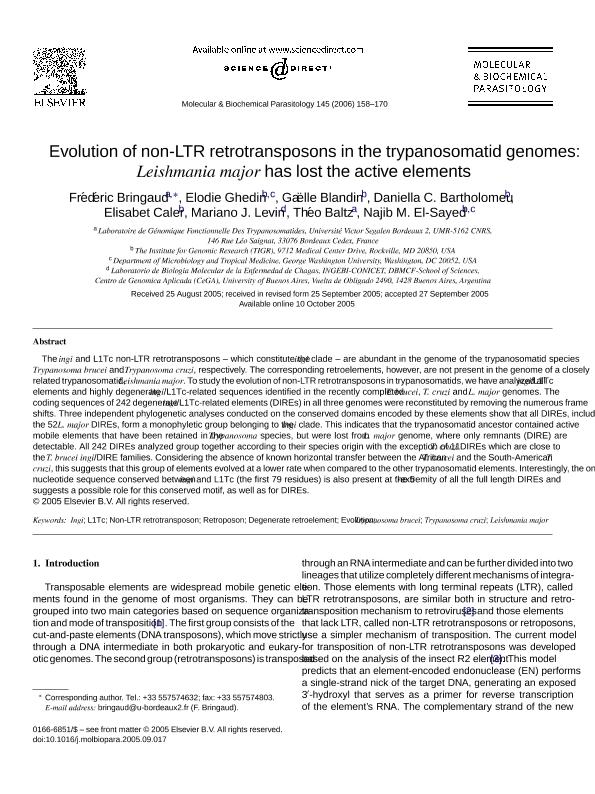Mostrar el registro sencillo del ítem
dc.contributor.author
Bringaud, Frédéric
dc.contributor.author
Ghedin, Elodie
dc.contributor.author
Blandin, Gaëlle
dc.contributor.author
Bartholomeu, Daniella C.
dc.contributor.author
Caler, Elisabet
dc.contributor.author
Levin, Mariano Jorge

dc.contributor.author
Baltz, Théo
dc.contributor.author
El Sayed, Najib M.
dc.date.available
2019-07-18T21:26:17Z
dc.date.issued
2006-12
dc.identifier.citation
Bringaud, Frédéric; Ghedin, Elodie; Blandin, Gaëlle; Bartholomeu, Daniella C.; Caler, Elisabet; et al.; Evolution of non-LTR retrotransposons in the trypanosomatid genomes: Leishmania major has lost the active elements; Elsevier Science; Molecular and Biochemical Parasitology; 145; 2; 12-2006; 158-170
dc.identifier.issn
0166-6851
dc.identifier.uri
http://hdl.handle.net/11336/79872
dc.description.abstract
The ingi and L1Tc non-LTR retrotransposons - which constitute the ingi clade - are abundant in the genome of the trypanosomatid species Trypanosoma brucei and Trypanosoma cruzi, respectively. The corresponding retroelements, however, are not present in the genome of a closely related trypanosomatid, Leishmania major. To study the evolution of non-LTR retrotransposons in trypanosomatids, we have analyzed all ingi/L1Tc elements and highly degenerate ingi/L1Tc-related sequences identified in the recently completed T. brucei, T. cruzi and L. major genomes. The coding sequences of 242 degenerate ingi/L1Tc-related elements (DIREs) in all three genomes were reconstituted by removing the numerous frame shifts. Three independent phylogenetic analyses conducted on the conserved domains encoded by these elements show that all DIREs, including the 52 L. major DIREs, form a monophyletic group belonging to the ingi clade. This indicates that the trypanosomatid ancestor contained active mobile elements that have been retained in the Trypanosoma species, but were lost from L. major genome, where only remnants (DIRE) are detectable. All 242 DIREs analyzed group together according to their species origin with the exception of 11 T. cruzi DIREs which are close to the T. brucei ingi/DIRE families. Considering the absence of known horizontal transfer between the African T. brucei and the South-American T. cruzi, this suggests that this group of elements evolved at a lower rate when compared to the other trypanosomatid elements. Interestingly, the only nucleotide sequence conserved between ingi and L1Tc (the first 79 residues) is also present at the 5′-extremity of all the full length DIREs and suggests a possible role for this conserved motif, as well as for DIREs.
dc.format
application/pdf
dc.language.iso
eng
dc.publisher
Elsevier Science

dc.rights
info:eu-repo/semantics/openAccess
dc.rights.uri
https://creativecommons.org/licenses/by-nc-sa/2.5/ar/
dc.subject
Degenerate Retroelement
dc.subject
Evolution
dc.subject
Ingi
dc.subject
L1tc
dc.subject
Leishmania Major
dc.subject
Non-Ltr Retrotransposon
dc.subject
Retroposon
dc.subject
Trypanosoma Brucei
dc.subject
Trypanosoma Cruzi
dc.subject.classification
Inmunología

dc.subject.classification
Medicina Básica

dc.subject.classification
CIENCIAS MÉDICAS Y DE LA SALUD

dc.title
Evolution of non-LTR retrotransposons in the trypanosomatid genomes: Leishmania major has lost the active elements
dc.type
info:eu-repo/semantics/article
dc.type
info:ar-repo/semantics/artículo
dc.type
info:eu-repo/semantics/publishedVersion
dc.date.updated
2019-07-18T13:01:33Z
dc.journal.volume
145
dc.journal.number
2
dc.journal.pagination
158-170
dc.journal.pais
Países Bajos

dc.journal.ciudad
Amsterdam
dc.description.fil
Fil: Bringaud, Frédéric. Universite Victor Segalen Bordeaux Ii; Francia
dc.description.fil
Fil: Ghedin, Elodie. The Institute for Genomic Research; Estados Unidos. The George Washington University; Estados Unidos
dc.description.fil
Fil: Blandin, Gaëlle. The Institute for Genomic Research; Estados Unidos
dc.description.fil
Fil: Bartholomeu, Daniella C.. The Institute for Genomic Research; Estados Unidos
dc.description.fil
Fil: Caler, Elisabet. The Institute for Genomic Research; Estados Unidos
dc.description.fil
Fil: Levin, Mariano Jorge. Consejo Nacional de Investigaciones Científicas y Técnicas. Instituto de Investigaciones en Ingeniería Genética y Biología Molecular "Dr. Héctor N. Torres"; Argentina. Universidad de Buenos Aires; Argentina
dc.description.fil
Fil: Baltz, Théo. Universite Victor Segalen Bordeaux Ii; Francia
dc.description.fil
Fil: El Sayed, Najib M.. The George Washington University; Estados Unidos. The Institute for Genomic Research; Estados Unidos
dc.journal.title
Molecular and Biochemical Parasitology

dc.relation.alternativeid
info:eu-repo/semantics/altIdentifier/url/https://www.ncbi.nlm.nih.gov/pubmed/16257065
dc.relation.alternativeid
info:eu-repo/semantics/altIdentifier/doi/http://dx.doi.org/10.1016/j.molbiopara.2005.09.017
dc.relation.alternativeid
info:eu-repo/semantics/altIdentifier/url/https://www.sciencedirect.com/science/article/pii/S0166685105002963
Archivos asociados
